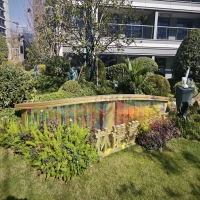Welcome to the website for landscape facilities products and knowledge.
How does the trash can’s design prevent the lid from being damaged by saltwater corrosion?
Saltwater corrosion is a significant challenge for outdoor trash cans, especially in coastal areas. To combat this, modern trash can designs incorporate several key features to protect the lid and extend its lifespan.
First, high-quality marine-grade materials like 316 stainless steel or powder-coated aluminum are often used. These materials inherently resist rust and degradation caused by saltwater exposure. The 316 stainless steel, in particular, contains molybdenum, which enhances its corrosion resistance.
Second, manufacturers apply specialized rust-resistant coatings. Epoxy or fluoropolymer coatings create an additional barrier between the metal and saltwater, preventing direct contact. Some designs even use double-layered coatings for extra protection.
Third, innovative drainage systems are integrated into the lid design. Small drainage holes or channels allow saltwater to quickly run off rather than pool on the surface, reducing prolonged exposure.
Fourth, plastic components in critical areas replace metal parts where possible. Hinges and locking mechanisms may use high-density polyethylene or other saltwater-resistant plastics to eliminate corrosion points.
Finally, some premium models feature sacrificial anode systems similar to those used on boats. These zinc or magnesium components attract corrosion away from the main structure, acting as replaceable shields.
By combining these design elements, modern trash cans can withstand harsh marine environments while maintaining functionality and appearance for years. Regular cleaning with fresh water further enhances this protection.
Related search:

Recommendation
Metal and acrylic color-changing combined curtain wall for large-scale public landscape facilities